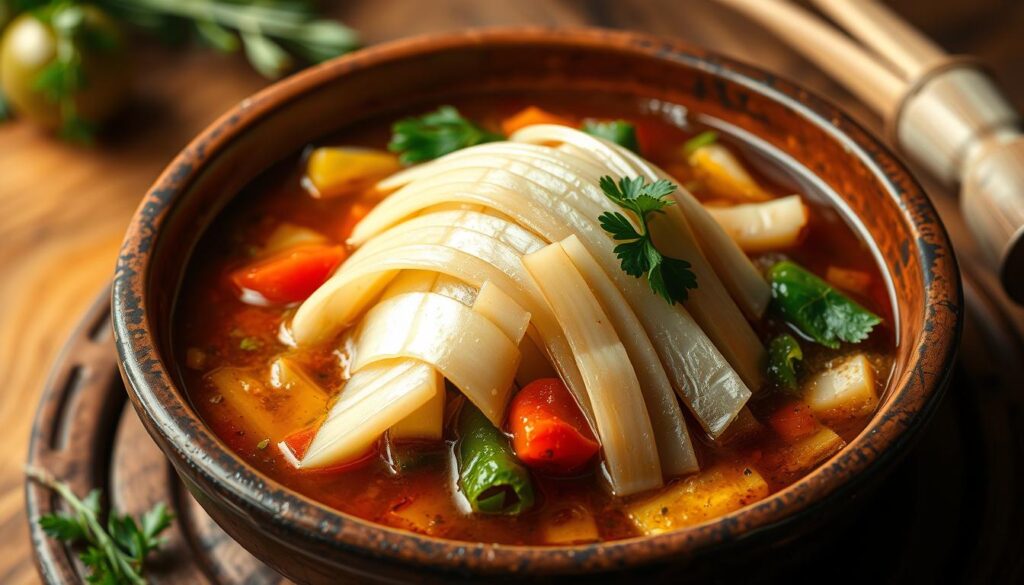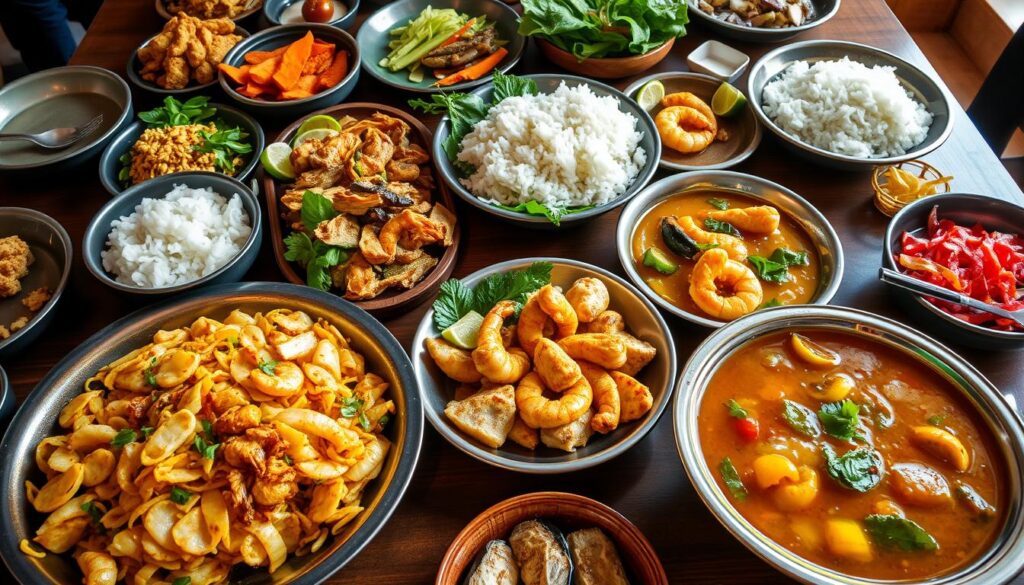The sharp, warm scent of fresh ginger is magical in the kitchen. For many, luya is more than a spice—it connects us to family meals. Think of the comforting lugaw or the savory Tagalog Batchoy broth.
This article will show you how to make easy, flavorful dishes with luya. You can make a hearty meal in under an hour. It serves six and has 18g protein per serving, plus vitamins A and C.
Whether you’re new to Filipino cooking or looking for budget-friendly meals, this luya recipe is perfect. It combines tradition with convenience. Learn how to cook with ginger to add bold flavors to soups, stews, or sides. It’s easy and doesn’t require complicated steps.

Table of Contents
What is Luya? Understanding the Essential Filipino Ingredient
Luya, or ginger root, is key in filipino ginger dishes. It has a rich history of over 2,000 years. It’s used in soups like lugaw and Batchoy Tagalog, mixed with garlic and onions.
This rhizome is more than a spice. It’s a cultural thread in daily meals and festivals.
The Cultural Significance of Ginger in Filipino Cuisine
Ginger has a special meaning in Filipino culture. It brings comfort and healing to over 100 ethnolinguistic groups. In ginger root cooking, it warms soups and aids in recovery after childbirth.
Its role in Noli Me Tangere shows its historical importance. Modern recognition, like TasteAtlas’s 2022 ranking, highlights its global appeal. Michelin’s 2026 Manila/Cebu guide also shows its growing fame.
Luya vs. Other Ginger Varieties: What Makes it Special
- Firm texture and sharp aroma set it apart from milder gingers
- Less fibrous than Indian ginger, perfect for slicing in soups
- Its unique pungency enhances coconut milk and fish sauce blends
Selecting and Storing Fresh Luya for Best Results
For the best ginger root cooking, pick firm, unwrinkled roots with a spicy scent. Store them in a cool, dark place for up to two weeks. Or freeze sliced pieces for longer.
Avoid shriveled roots to get the best flavor in dishes like sinigang or pancit.
Health Benefits of Cooking with Luya
Cooking with luya does more than just add flavor. It boosts your health. Ginger spice recipes like tea or stir-fries can help with muscle pain and digestion. The active compounds in ginger, called gingerols, fight inflammation and nausea.
Studies show that using ginger daily may lower blood sugar and cholesterol. This makes ginger a great addition to your meals.
- Anti-Inflammation: Gingerols may ease arthritis pain. A 2019 review found ginger helped reduce arthritis discomfort.
- Digestion: Relieves nausea and speeds stomach emptying. Try best ginger recipes like tea for morning sickness relief.
- Heart Health: A 2022 review found ginger lowered LDL cholesterol and raised HDL. Sprinkle in soups or smoothies for heart benefits.
- Antimicrobial: Fights bacteria like E. coli. Use fresh ginger in salads or teas to preserve germ-fighting properties.
- Antioxidants: May combat chronic diseases. Add to marinades or stir-fries for maximum antioxidant intake.
| Benefit | Key Findings | Recipe Tips |
|---|---|---|
| Menstrual Pain | 1,500mg daily reduced discomfort (study). | Sip warm ginger tea during cramps. |
| Blood Sugar | 2g powder daily improved levels in diabetics. | Grate fresh ginger into best ginger recipes like stir-fried veggies. |
| Anti-Cancer | Lab studies show it inhibits cancer cell growth. | Pair with turmeric in curries for dual antioxidant power. |
Quick cooking preserves ginger’s compounds. Steep 10 minutes for tea or sauté briefly in stir-fries. These ginger spice recipes turn science into simple meals. Make wellness a part of every dish.
Essential Ingredients for the Perfect Luya Recipe
Creating ginger recipe ideas that stand out begins with the right ingredients. Each part, from classic items to fresh herbs, is crucial. They help make tasty dishes with ginger like lugaw or Batchoy Tagalog.
Traditional Filipino Ingredients to Complement Luya
Combine luya with patis (fish sauce) for a salty taste and calamansi for a zesty kick. Chili leaves bring the heat, while pork offal in Batchoy Tagalog adds richness. Medy’s Arroz Caldo De Oro and Luna’s Arrozcaldohan have used these mixes for over 50 years.
Pantry Staples You’ll Need
- Jasmine rice for lugaw’s creamy base
- Vegetable oil and fish sauce
- Black pepper and kosher salt
Make sure to have these basics on hand. They’re key for quick ginger recipes.
Fresh Components That Enhance Ginger Flavor
Use bone-in chicken thighs for a rich stock and green onions for a garnish. Fresh ginger pieces (4 inches) and scallions boost the flavor. If luya is hard to find, try using galangal instead.
| Ingredient | Quantity |
|---|---|
| Jasmine rice | 1.5 cups |
| Fresh ginger | 4-inch piece, julienned |
| Chicken thighs | 1.5 lbs |
| Calamansi | 4 pieces, juiced |
| Green onions | ½ cup, chopped |
Combine these with pantry items for a well-rounded dish. Adjust the amounts to serve 6–8 people.
Quick and Easy Luya Recipe for Beginners

Begin your luya adventure with this quick luya recipe that’s ready in under 30 minutes. It’s perfect for busy weeknights or relaxing afternoons. This ginger tea combines tradition with ease, making it great for beginners in Filipino cooking.
Prep Time and Cooking Time
- Prep: 5 minutes
- Cook: 15 minutes
- Total: 20 minutes
Step-by-Step Cooking Instructions
- Peel and grate 4 oz fresh luya (about 5-inch piece). Thin slices work if grater isn’t available)
- Boil 6 cups water in medium saucepan. Add ginger and simmer 10-15 minutes
- Strain liquid into mugs. Stir in ¼ cup honey or sugar to taste
- Optional: Garnish with lemon wedges or cinnamon sticks
Serving Suggestions
Serve warm with:
- Pan de sal bread for dipping
- Steamed rice cakes (kakanin)
- Spiced ginger ale for a mocktail version
| Nutrition Facts (per serving) |
|---|
| Calories: 58 kcal |
| Carbs: 15g |
| Fiber: 0.4g |
| Vitamin C: 1mg |
| Sugar: 12g |
“In many Visayan households, this tea is served with silkworm pupae (bagoong alamang) for umami depth.”
For ginger recipe ideas, freeze extra brew in ice cubes for smoothies later. Double the ginger for a stronger taste, or add lemon grass for a tropical flavor. This basic luya recipe is easy to customize while keeping its Filipino roots.
Advanced Techniques to Elevate Your Ginger Dishes
Learning ginger cooking tips can transform simple meals into works of art. Begin by making aromatic oils with ginger slices. Try julienning for texture or grating for intense flavor. These techniques help you use ginger in creative ways.
- Caramelize ginger slices in oil for a sweet, nutty edge.
- Add raw ginger early in soups to meld flavors or late in stir-fries for bright accents.
- Blend into pastes for marinades or sauces.
| Technique | Heat Level | Result |
|---|---|---|
| Infused Oils | Medium (180°F) | Rich aroma foundation |
| Caramelize | High (375°F) | Sweet, crispy texture |
| Simmer | Low (180°F) | Mellow background notes |
Make garnishes like crispy fried ginger bits or ginger-infused syrups. Try caramelizing pork with fish sauce for a rich flavor. Finish dishes with fresh ginger shreds. These ginger cooking tips help you create dishes with a professional touch. By practicing these methods, you can explore ginger’s full range of flavors in your cooking.
Common Mistakes to Avoid When Cooking with Luya
Mastering ginger’s bold flavor starts with avoiding simple oversights. These ginger cooking tips ensure your dishes stay balanced and fresh every time.
- Peel only when needed: Thin-skinned young ginger can stay unpeeled. Use a spoon to scrape instead of peeling tender roots.
- Match cuts to the dish: Grate for marinades, slice for soups, or julienne for stir-fries. Overly large pieces may stay tough.
- Avoid powdered substitutions: Fresh ginger’s heat spreads differently. Use 1 tsp powder = 1 tbsp fresh to prevent overpowering dishes.
Flavor imbalance? Start with small quantities. Adjust with coconut milk, honey, or citrus to soften sharpness. For ginger root cooking, test portions early to avoid overdoing it.
- Store fresh ginger in a sealed bag in the fridge’s crisper drawer for 3 weeks.
- Freeze grated ginger in ice cubes with water for quick use later.
- Pickle or dry excess ginger to preserve it long-term. Avoid leaving at room temperature for more than 2 days.
Inspect ginger regularly. Discard if moldy or discolored. Proper storage prevents waste and keeps its spicy kick intact. Adjust techniques based on your recipe’s needs, and enjoy consistent results every time.
Variations of Traditional Luya Recipes from Different Filipino Regions
Explore the filipino ginger dishes that show each region’s unique flavor. From Luzon’s hearty soups to Mindanao’s fragrant blends, luya’s flexibility is clear in these local twists.
- Northern Luzon: Try Batchoy Tagalog, a pork-based soup with ginger-infused broth. The earthy taste goes well with chewy miswa noodles.
- Central Luzon: Everyday dishes like laing use ginger to balance bitter gourds. Festive meals turn it into rich stews with coconut milk.
- Visayas: In the Visayas, pospas (rice porridge) is a contrast to Tagalog lugaw’s simplicity. Spiced with shrimp paste and ginger, it’s a breakfast favorite.
- Mindanao: Coastal communities mix ginger with turmeric and lemongrass, creating bold curries. These best ginger recipes show Spice Route influences.
Try these regional recipes to grow your cooking skills. Whether making Visayan pospas or Mindanao’s spiced soups, luya’s flexibility shows the Philippines’ rich cultural heritage.
Pairing Your Luya Dish with Other Filipino Favorites
Make your tasty dishes with ginger even better by adding classic Filipino sides and drinks. Ginger’s strong taste is best when paired with dishes that complement it. Choose sides and drinks that don’t clash with the ginger’s heat.

- Try steamed white rice or lugaw (rice porridge) topped with crispy garlic, scallions, or pork cracklings. These textures contrast well with ginger’s sharpness.
- Vegetables like pinakbet (stir-fried vegetables in bokchoy sauce) or ensaymada (sweet cheese bread) add sweetness to counter ginger’s spiciness.
- Starchy dishes such as sinangag (garlic fried rice) or pandesal bread absorb bold flavors without overpowering.
Beverage Pairings:
- Refresh with tangy calamansi juice or coconut water to cut through richness.
- For warmth, serve ginger-infused tea or sambong tea alongside filipino ginger dishes.
- Cold brew coffee or iced tsokolate (chocolate drink) balance heat with creamy notes.
Complete Meal Tips:
Set up your meal like a traditional Filipino feast. Start with kinilaw (ceviche) for freshness. Then, serve your filipino ginger dishes as the main attraction. Finish with mango float for a sweet treat. Make sure no dish overpowers the ginger’s unique flavor.
Conclusion: Embracing the Vibrant Flavors of Luya in Your Kitchen
Luya brings a world of flavors to Filipino cooking. It adds warmth to dishes like Batchoy Tagalog and a zesty kick to ginger tea. You now know how to pick, store, and balance its bold flavors.
Luya is more than a spice; it supports digestion and boosts immunity. Start with simple recipes and build your skills. Try different regional versions to see how Luya is used in soups, stir-fries, and drinks.
Luya pairs well with garlic, soy sauce, or coconut milk. Let its cultural heritage inspire you as you innovate. Every meal connects you to Filipino traditions, blending old with new. Your kitchen is ready to explore and turn meals into flavorful adventures.
FAQ
What is luya and how is it used in Filipino cooking?
Luya, or ginger, is key in Filipino cooking. It adds a unique flavor and aroma. It’s used in dishes like lugaw (rice porridge) and Batchoy Tagalog. It’s often mixed with garlic and onions for a tasty base.
What are the health benefits of ginger?
Ginger is known for its anti-inflammatory effects. It helps with muscle pain and soreness. It also aids digestion, fighting nausea and stomach issues. Studies show it may lower blood sugar and heart disease risk.
How can I select and store ginger for maximum freshness?
Choose firm ginger with smooth skin and a strong smell. Store it in a cool, dry spot. For longer life, refrigerate or freeze it after cleaning and preparing.
What are some traditional ingredients that complement luya?
Patis (fish sauce), calamansi (Filipino citrus), and local veggies like chili leaves go well with ginger. They balance out its strong flavor, making dishes more enjoyable.
Can you recommend a simple luya recipe for beginners?
Yes! Making ginger tea is easy. Just peel and grate the ginger, then simmer it in water for 10 minutes. Add honey or lemon for extra taste. It’s a great recipe for beginners.
What are some advanced techniques to use with luya?
Advanced methods include infusing oils with ginger or caramelizing it. Techniques like julienning or grating can also improve texture and flavor. Adding ginger at different cooking stages adds depth to dishes.
What common mistakes should I avoid when cooking with ginger?
Avoid using the wrong ginger form for dishes and balancing flavors incorrectly. Proper preparation and storage are key to keeping ginger fresh and flavorful.
How does the use of ginger vary across different regions of the Philippines?
Ginger traditions vary by region. In Northern Luzon, Batchoy Tagalog uses ginger in a hearty broth. Other areas use ginger in dishes like pospas (similar to lugaw), with unique flavors and methods.
What are some ideal pairings for dishes featuring luya?
Pair ginger dishes with vegetable stir-fries or quick pickles. For drinks, try calamansi juice or coconut water. These complement ginger’s flavor, enhancing your meal.
Source Links
- https://www.kawalingpinoy.com/batchoy-tagalog/
- https://www.eatfigsnotpigs.com/ginisang-munggo-filipino-mung-bean-soup/
- https://en.wikipedia.org/wiki/Filipino_cuisine
- https://kusinasecrets.com/tinolang-manok-filipino-chicken-ginger-soup/
- https://www.healthline.com/nutrition/herbs-to-lower-blood-pressure
- https://www.healthline.com/nutrition/11-proven-benefits-of-ginger
- https://www.webmd.com/diet/ss/slideshow-health-benefits-ginger
- https://www.philstar.com/lifestyle/food-and-leisure/2024/10/20/2389480/beneficial-spice-health-benefits-luyang-dilaw
- https://www.thekitchn.com/lugaw-recipe-23086700
- https://panlasangpinoy.com/arroz-caldo/
- https://kusinasecrets.com/salabat-traditional-filipino-ginger-tea/
- https://www.kawalingpinoy.com/bicol-express/
- https://kusinasecrets.com/filipino-balbacua-recipe/
- https://kusinasecrets.com/filipino-goto-beef-tripe-congee/
- https://www.medicalnewstoday.com/articles/318405
- https://www.britannica.com/plant/ginger
- https://www.kawalingpinoy.com/dinuguan/
- https://kusinasecrets.com/filipino-beef-lauya/
- https://panlasangpinoy.com/dinengdeng-with-fried-fish-recipe/
- https://panlasangpinoy.com/slow-cooked-beef-lauya-soup-recipe/
- https://kitchenconfidante.com/homemade-fresh-ginger-tea









